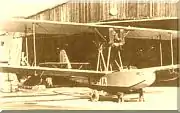| CANT 7 | |
|---|---|
 | |
| Role | Flying boat trainer |
| Manufacturer | CANT |
| Designer | Raffaele Conflenti |
| First flight | 1924 |
| Primary user | Società Italiana Servizi Aerei |
| Number built | 34 |
The CANT 7 was a flying boat and training aircraft that was produced in Italy in the 1920s. It was a conventional biplane design with single-bay, unstaggered wings of equal span, with the single engine mounted below the upper wing. The aircraft was designed to prepare pilots for flying boat airliners, and most of the examples produced were purchased by Società Italiana Servizi Aerei for this purpose.
Operators
- Società Italiana Servizi Aerei (S.I.S.A.)
Specifications
General characteristics
- Crew: 2, pilot and instructor
- Length: 9.15 m (30 ft 0 in)
- Wingspan: 11.80 m (38 ft 8 in)
- Empty weight: 935 kg (2,061 lb)
- Gross weight: 1,350 kg (2,976 lb)
- Powerplant: 1 × Isotta Fraschini V.4BB , 112 kW (150 hp)
Performance
- Maximum speed: 165 km/h (103 mph, 90 kn)
- Endurance: 4 hours
See also
Related lists
References
Wikimedia Commons has media related to CANT 7.
- Taylor, Michael J. H. (1989). Jane's Encyclopedia of Aviation. London: Studio Editions. p. 269.
- aerei-italiani.net
This article is issued from Wikipedia. The text is licensed under Creative Commons - Attribution - Sharealike. Additional terms may apply for the media files.